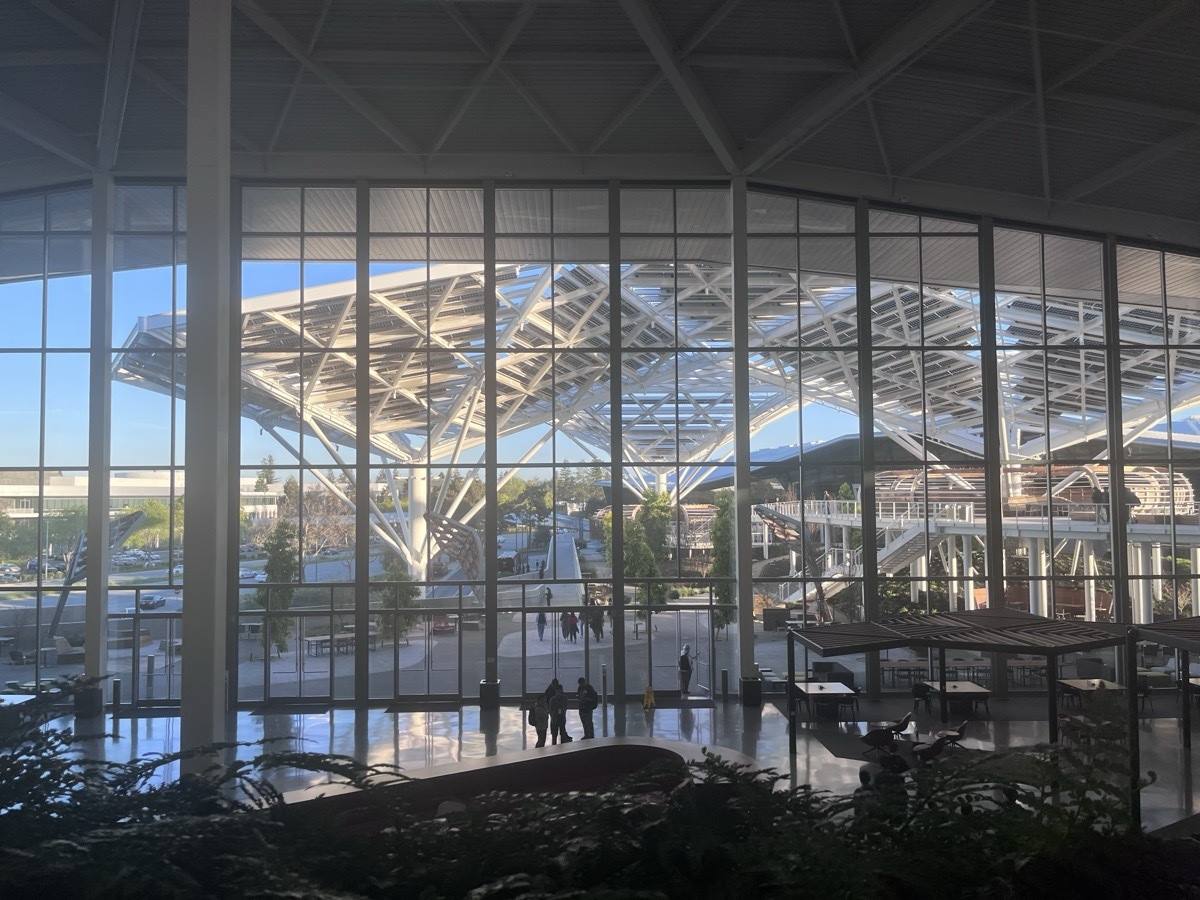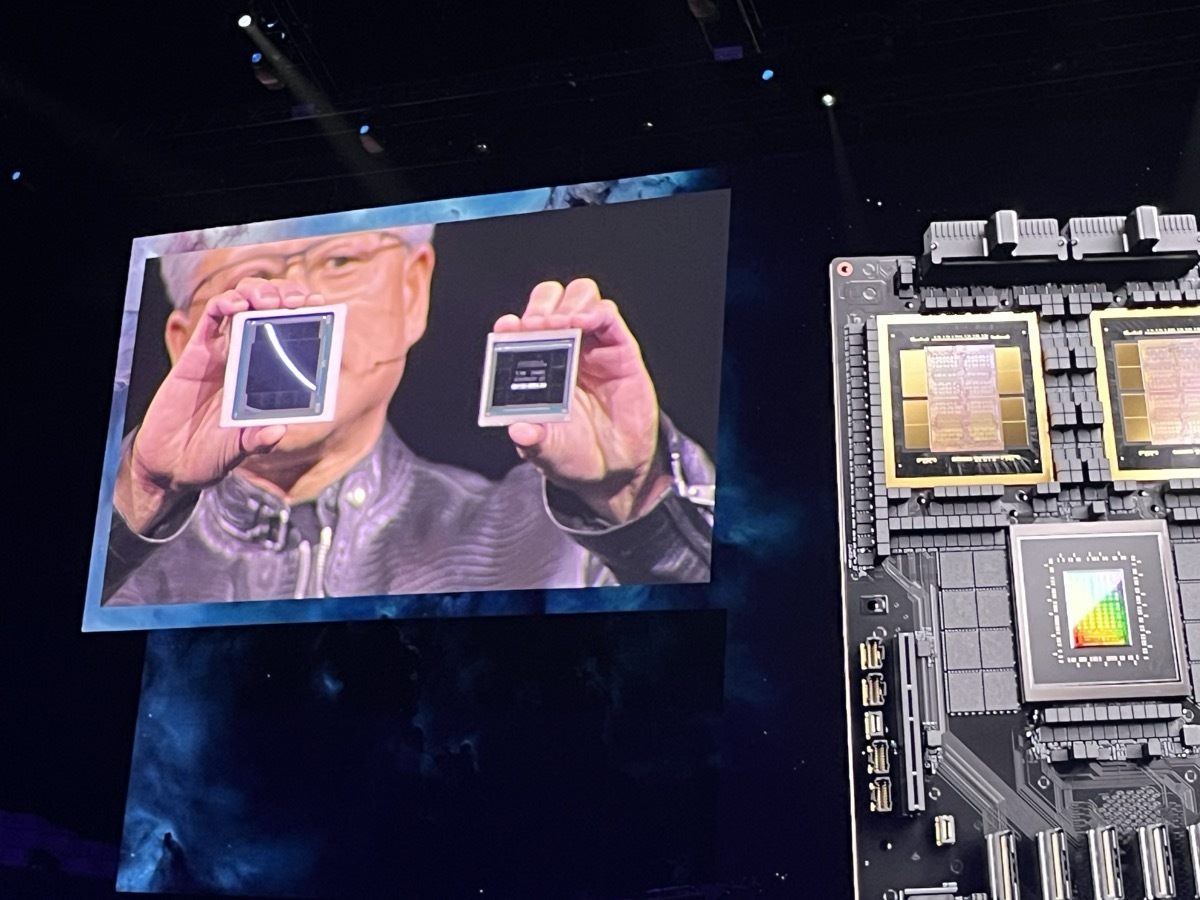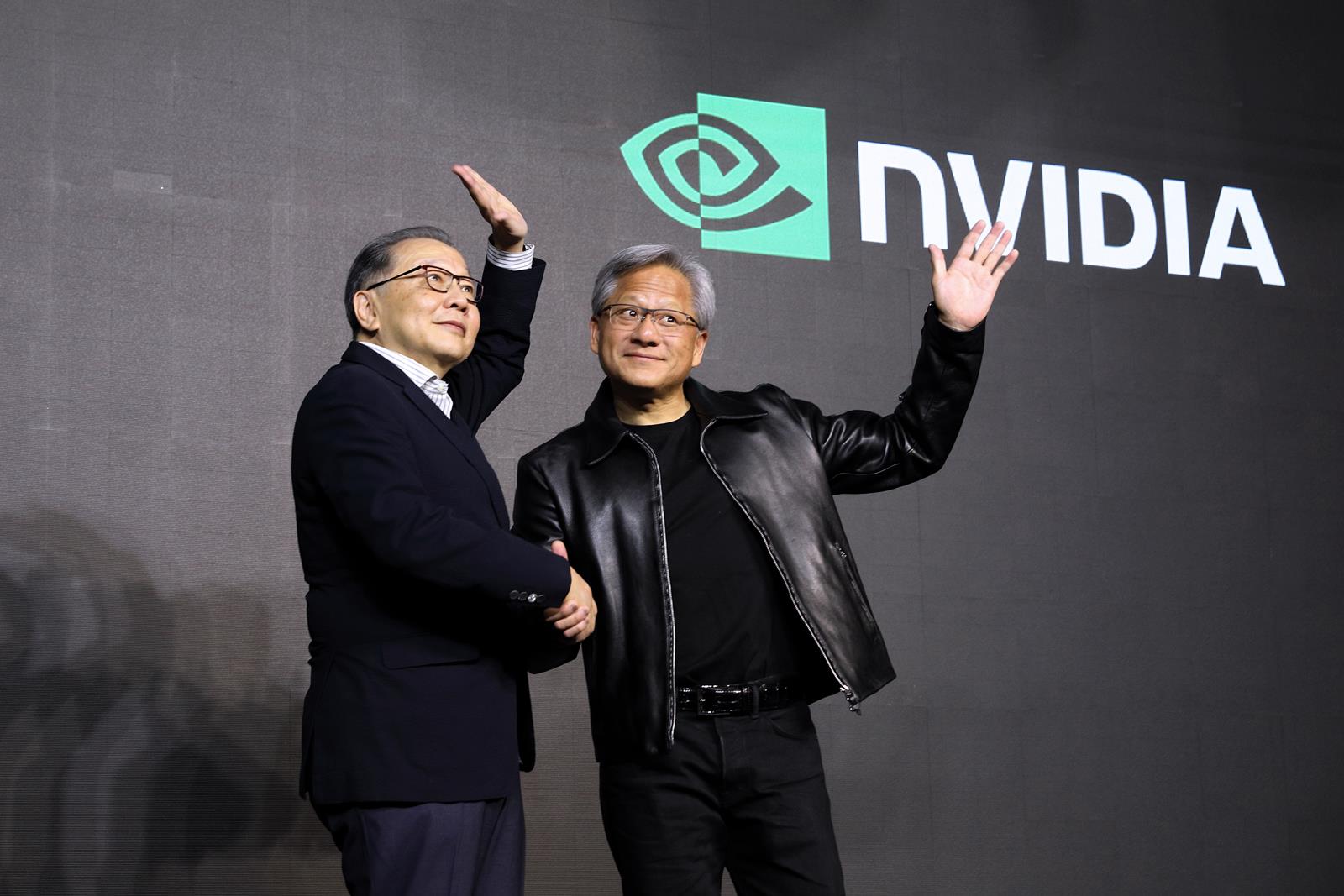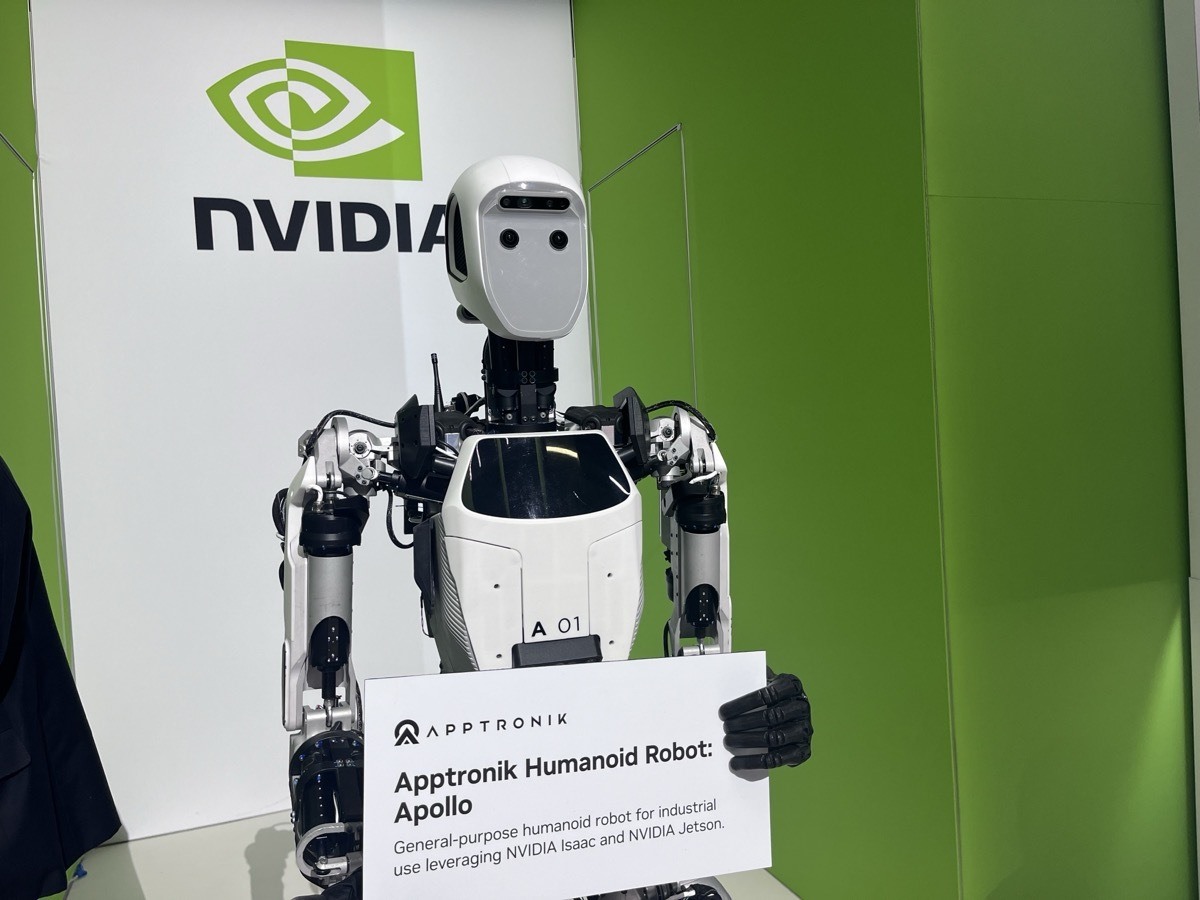A look inside NVIDIA and Jensen Huang’s ambition

Source:AP
In a visit to NVIDIA's headquarters in Silicon Valley, Jensen Huang explains why he believes NVIDIA is not just a chip company but an "AI platform enterprise."
Views
A look inside NVIDIA and Jensen Huang’s ambition
By Yixuan Linweb only
On March 19th, NVIDIA CEO Jensen Huang took to the stage at the annual GTC event to unveil the BlackWell GPU architecture, boasting greater size and computational power, thus reigniting the frenzy surrounding NVIDIA's supply chain and the capital market's enthusiasm for AI.
Journalists from around the world ventured into NVIDIA's headquarters, witnessing the birthplace of chips continually breaking computational ceilings.
As our car traversed Silicon Valley, alongside the Santa Clara-St. Thomas Expressway, a gray building with a massive wavy canopy stood out conspicuously against the flat road.
This is the new NVIDIA headquarters, connected by a sky bridge between two four-story main buildings. Amidst the plant-lined walkways between them, various bird's nest seats are nestled, creating a digital garden-like ambiance.
 The headquarter of NVIDIA. (Photo: Yixuan Lin)
The headquarter of NVIDIA. (Photo: Yixuan Lin)
Immersed in AI at NVIDIA headquarters
Upon entering the headquarters, one is greeted not only by an endless array of green plants but also by offices of varying heights stacked upon each other like hills, creating a strong sense of technology intertwined with vitality.
NVIDIA employees revealed that during the construction of the headquarters, NVIDIA utilized its in-house digital twin technology to simulate before building. Every hour, even the angles and intensity of light were precisely calculated, controlling the indoor lighting and air conditioning.
From the ceiling to the tiles and shading structures, the ubiquitous triangular elements symbolize NVIDIA's origins in 3D graphics chips.
In one corner of the company lobby, there is a display of merchandise adorned with the NVIDIA logo. This isn't just because employees enjoy carrying NVIDIA backpacks; in recent years, an increasing number of AI enthusiasts visiting the company never fail to grab souvenirs.
Among these, the hottest-selling item is a shirt emblazoned with "I am AI," perfectly echoing NVIDIA's transformation from a company with a stock price of just $1.5 at one point, facing bankruptcy, to becoming one of the top three companies globally in terms of market value—a journey driven by artificial intelligence.
"NVIDIA is no longer just a company; it has become a belief in the era of AI," remarked a technology analyst who participated in NVIDIA's 2024 GTC conference.
The mighty AI chip GB200 to propel a new industrial revolution
At this year's GTC event at the San Jose Convention Center, NVIDIA proved to the world that only NVIDIA can surpass NVIDIA. Just last year, Jensen Huang, who was recently named the world's most popular CEO, showcased the Hopper GPU that sparked a craze. This year, he revealed an even larger GPU architecture—BlackWell.
Proudly brandishing the latest GPU architecture in his hands, Huang emphasized, "Hopper was a good boy, but BlackWell..." with confidence, he said, "This is definitely a more powerful GPU."
NVIDIA's 2022 release of the H100 AI chip based on the Hopper architecture propelled a frenzy in generative AI. The GPU named after David Blackwell, the first black scientist to be elected to the US National Academy of Sciences, surpasses its predecessor in computational power.
 (Photo: Yixuan Lin)
(Photo: Yixuan Lin)
Comparing, Huang highlighted the performance of the GB200 chip, composed of two BlackWell architecture B200 GPUs and one Grace CPU, fabricated using TSMC's 4-nanometer process. In benchmark tests based on the 175 billion parameter GPT-3 model, its performance is seven times that of the H100, with training speeds increased by four times and inference capabilities improved by 30 times.
"Generative AI is the decisive technology today, and the BlackWell GPU will be the engine driving this new industrial revolution," Huang stated.
"Now, it's almost impossible to say you're doing AI without intending to use NVIDIA's chips," lamented the aforementioned technology analyst at the GTC event.
NVIDIA's technology-laden headquarters has become a dazzling new landscape in Silicon Valley. In fact, over the entire weekend, San Jose in the US transformed into "NVIDIA City," with every bus stop adorned with the iconic NVIDIA green symbol. The GTC event even saw street closures, with local authorities deploying police and drug-sniffing dogs to maintain order.
Tech giants scramble for chips: "Not worried about the price, worried about missing out
Just after Jensen Huang's keynote speech, Frank Lee, an analyst at HSBC Bank, raised NVIDIA's target stock price from $880 to $1050. In his report, he pointed out that this time NVIDIA not only defended its position in the AI field but also launched a comprehensive layout of AI products centered around the latest GB200 chip, a move he deemed more important than the GPU itself.
The core of building an AI platform, of course, lies in the newly released chips.
While Jensen Huang did not directly disclose the chip's price, he admitted it is "quite expensive." Currently, the H100 chip sells for up to US$40,000 per unit, and the price of the GB200 chip is expected to be even higher.
"But price is hardly a concern for these companies," analyzed a supply chain professional present at the event. "Given the performance announced this time, what worries everyone more is similar to the last generation—what if we miss out."
In fact, Jensen Huang announced that several tech giants, including Amazon, Google, Meta, Microsoft, OpenAI, and Oracle, will use BlackWell.
Gigabyte, Wistron, Hon Hai, and Wiwynn dive into the supply chain
Moreover, Taiwan's industry is eagerly gearing up for the "Jensen Huang supply chain." Companies like Gigabyte, Wistron, Hon Hai, and Wiwynn not only set up booths and showcased their technologies at this year's GTC but also announced securing the first orders for NVIDIA's latest GPUs, becoming the earliest companies to design the GB200 chip.
Take Hon Hai, for instance. The display Huang presented at GTC is Hon Hai Group's latest generation AI data center liquid cooling solution, the GB200 NVL72.
The key here lies in the NVL72, which houses 72 high-performance NVIDIA BlackWell GPUs and 36 NVIDIA Grace CPUs, significantly accelerating the inference speed of large language models. Moreover, its advanced liquid cooling solution boasts a powerful heat dissipation capacity of up to 1300kW, adaptable to different data center environments.
In fact, Hon Hai Chairman Young Liu revealed in a March earnings call that GPU module revenue would experience triple-digit annual growth rates this year, with AI server revenue expected to grow by over 40%.
Not just Hon Hai, last year's beneficiary of the Jensen Huang supply chain, Wistron, saw CEO Jeff Lin also reveal in a March earnings call that Taiwan would expand its new factories. Wistron's main AI server boards and system assemblies are primarily located in Taiwan.
Furthermore, it was unveiled at the GTC event that Wistron's factory is already utilizing NVIDIA's Omniverse software development platform for digital twinning, enabling digitalization in manufacturing.
Although it wasn't further disclosed whether this was for an AI server production line, it clearly demonstrated the close integration between NVIDIA and Taiwan's supply chain.
AI in automotive: Collaboration with BYD and MediaTek
NVIDIA's prowess doesn't stop at showcasing its GPU dominance; it extends deep into the automotive AI and robotics realms.
In the automotive AI sector, NVIDIA has found a natural fit with its self-driving systems, from the Orin and Atlan autonomous chips to the Drive Thor, achieving a computational power increase of about 2000 TOPS (Tera Operations Per Second) over the past three years—about 800 times more powerful than a similar chip by Intel's Mobileye.
During the event, Huang showcased NVIDIA's collaboration with BYD, recently crowned the world's largest electric vehicle manufacturer, displacing Tesla. The partnership aims to utilize NVIDIA's next-generation AI chip for automotive use, Drive Thor, to enhance the vehicle's autonomous driving capabilities and other digital features.
This partnership not only highlights Huang's astuteness in seizing the rapid growth of BYD but also expands NVIDIA's market share in automotive AI.
Observers are curious about the progress of the collaboration announced at Taiwan's Computex last May between Huang and MediaTek's CEO, Rick Tsai, in the automotive cabin area. This collaboration stemmed from NVIDIA and MediaTek sharing a common adversary—Qualcomm.

At that time, industry watchers believed that NVIDIA teaming up with MediaTek could enable entry into the automotive cabin sector previously unexplored by NVIDIA, leveraging MediaTek's expertise in multimedia and communication chip designs.
Last year, Tsai mentioned MediaTek's Dimensity Auto automotive platform, integrating NVIDIA's GPU small chips, AI, and graphics IP with MediaTek's Helio processors, slated for launch and sales by MediaTek starting in 2026.
True to this, at this year's GTC, MediaTek proactively announced a new Dimensity Auto intelligent cabin system-on-chip (SoC), integrating ARMv9-A architecture, next-gen NVIDIA GPUs, and ray tracing graphics technology, offering various AI cabin experiences for different vehicle models, such as supporting chatbot functions within cars.
This development marks the official unveiling of MediaTek's Dimensity Auto intelligent cabin automotive platform following the handshake between Tsai and Huang last year.
"Generative AI is revolutionizing the automotive industry," stated You Ren-jie, General Manager of MediaTek's Computing and Connectivity Business Group, highlighting the personalized, intuitive computing experience that will bring a new AI cabin entertainment experience to the automotive industry.
Robotics: Flexing its muscles
However, what caught everyone's attention and cannot be ignored is Huang's deep dive into robotics.
Apart from showcasing six humanoid robots, NVIDIA also presented two dog-like robots that mimic real dogs. These robots not only displayed cuteness but also demonstrated agility at the GTC exhibition—engineers commanded them with voice instructions, and they swiftly ran, jumped, and even climbed heights, showcasing agility comparable to real canines.
Huang announced the upcoming Project GR00T humanoid robot, stating, "Humanoid robots can understand natural language and learn coordination, flexibility, and other skills faster through observation and imitation, thus integrating into the environment and interacting with the real world."
A senior engineer familiar with NVIDIA told CommonWealth that Robotics integrating with NVIDIA's Omniverse allows for virtual space robot operations, with vast application potential across industries.
 NVIDIA is intergrating its robots into Omniverse platform. (Photo: Yixuan Lin)
NVIDIA is intergrating its robots into Omniverse platform. (Photo: Yixuan Lin)
Becoming the "TSMC of AI": Beyond just chips
While outsiders still perceive NVIDIA as the AI chip champion, Huang, with his far-reaching vision, has positioned the company as an AI platform, empowering NVIDIA's customers with AI computing power.
"We want to be like TSMC, creating products for everyone," he said. "Just as everyone goes to TSMC with ideas, TSMC produces the chips; we're doing the same. This is 'AI foundry.'"
He remains optimistic about the future, stating, "We are at the beginning of AI computing growth."
As NVIDIA's influence continues to permeate various industries, from chips to AI platforms, from automotive to robotics, Jensen Huang's vision of NVIDIA as an AI powerhouse echoes throughout Silicon Valley, setting the stage for a transformative era in technology and artificial intelligence.
Have you read?
- How AI stock Socionext became Japan’s largest IPO
- Behind AMAX, one of NVIDIA’s earliest partners
- Why is Foxconn building "AI factories" with Nvidia
Uploaded by Ian Huang






